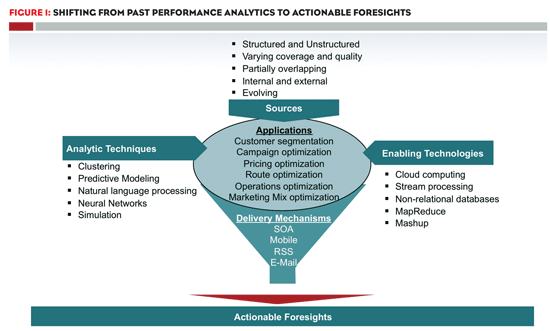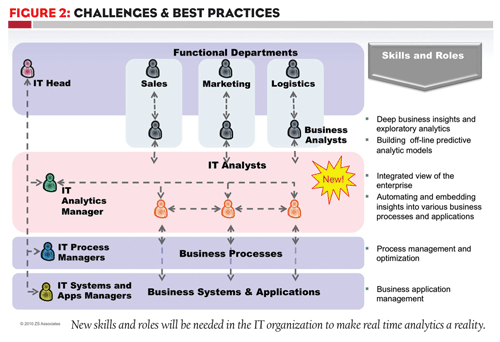Recent improvements in technology and analytics will help pharmaceutical companies respond to market demand faster than ever before.
A sales representative leaves a primary care physician’s office. Normally, he’d follow a predefined customer list and make his next call with a doctor group across town. But as he approaches the car, his smart phone vibrates. An alert notifies him that a nearby practice serves a large patient population enrolled in a recently contracted regional healthcare plan.
After he taps a link in the message, a Google map directs him to the suggested office. A compact screen describes the practice, patient population, prescribing tendencies, and relevant medical positions on local managed-care formularies. Another message summarizes the doctors’ recent activities on company websites, conferences, and call centers, and reminds the rep of key brand, payer, and compliance messages. The sales representative arrives at the unplanned call, fully prepared to present his therapies.
Welcome to the modern pharmaceutical company’s agile sales and marketing teams. These new teams are supported by technology that can analyze in real time terabytes of information, summarize results in digestible form, and optimally place “byte-sized” insights seamlessly into business processes—all so that the information is available to the representative just in time for a sales call.
The opening scenario is just one example of how pharma company IT departments can match their peers in other industries. The trend across many industries is to combine big data, predictive analytics, technological mobility, and social media. Doing so allows them to accelerate the pace at which sales reps and executives in various departments make the best decisions possible.
Over the last several years, pharmaceutical companies have invested significantly in collecting or purchasing data; and with the emergence of patient-level data and EMR data, the trend is likely to continue. Advanced data repositories now include information as varied as patient demographics, physician prescribing history, and group practice hours. Some repositories even have information on doctors’ policies regarding sales reps’ visits, the doctors’ interests, and their preferences. Additionally, the data are becoming increasingly unstructured, including rep-recorded customer observations and records from professional websites and call centers.
Despite these advances, most pharmaceutical manufacturers still rely on old-fashioned, people-powered analytics teams to study the information, prepare standard reports, and publish them periodically. There’s an opportunity for IT to automate many of these analytical efforts, make the information available instantly, and deliver it automatically to those who need it most.
While not all business analytics can be automated, there are great opportunities to improve sales and marketing, particularly with respect to the following examples: customer segmentation, customer coverage strategy, and customer tactics.
AUTOMATE CUSTOMER SEGMENTATION
Pharmaceutical companies invest heavily in marketing campaigns aimed at physicians. To help maximize their effectiveness, companies target these efforts as precisely as possible, based on physicians’ needs, values, and prescription histories, among many other attributes.
Collecting, sorting, and analyzing the information necessary to create and update segmentations is labor intensive, however, and many pharma companies update segmentations only once or twice each year.
Unfortunately for the sales and marketing departments, physicians’ practices change more often than that. As a result, marketing campaigns can lag behind reality, perform less effectively than they should, waste millions of dollars, and annoy physicians.
With improved computing power and business analytics, however, the IT department can automate the segmentation—or re-segmentation— of customers in real time, using up-to- date data from multiple channels and sources. Starting from straight-forward, rule-based systems, and progressing to more sophisticated clustering models, technology can help to shorten the time it takes to update customers’ segmentations and target them with the most appropriate marketing campaigns. As a result, automated customer segmentations will help improve customer relations and increase revenues.
COORDINATE CUSTOMER COVERAGE
Sales and marketing executives today study enormous amounts of data to devise their channel strategies but often execute those strategies in silos—and review them only once each year. Though reasonably effective, this approach eliminates the opportunity to capitalize on synergies that might arise between channels or to respond quickly to market events (e.g., changes in formulary status or competitor moves).
Appropriate analytics techniques allow pharma companies to create optimal customer-level marketing. The programs can infer which physicians pharma companies should cover with which marketing channels, and how much coverage should be given to each segment.
Automating that analytics program allows a pharma company to monitor multi-channel data and automatically send differences in doctors’ responses to various marketing channels. While one group of doctors may increase its prescription in response to samples accompanied by a personal call, for example, another group may respond just as well to samples shipped directly to its office. An automatic shipment of the optimal number of samples would allow the representative to reallocate his time to the doctors from the first group.
Once put in place, channel coordination systems would alert sales representatives to increase calls or sampling levels to prescribers who respond best to that marketing channel, and decrease the time and resources to those who do not. It also would help brand managers start or modify email campaigns to reach doctors in vacant territories, or aid account managers in targeting a local payer once sales exceed the desired threshold. Coordination and near–real-time budget reallocation between channels can maximize the return on every dollar—especially important in a time of shrinking margins and expiring patents.
OPTIMIZE CUSTOMER TACTICS
Through predictive and automated analytics programs, the sales representatives of tomorrow can know the next steps their customers require, how to reach them through the most responsive channels, the optimal time to approach them, and the most effective messages to use.
Dynamic targeting is one prime example of automated, predictive analytics optimizing customer tactics—as with the alert sent to that salesman’s phone. Such a task, however, requires reconciling an overwhelming amount of information: the relative value of doctors, their response to different channels, a multitude of possible messages, the recent history of salesperson-doctor interactions, and the time and effort it takes to visit the physician. All of these factors influence what is the best, most effective approach for a rep to take now or next week. This dynamic targeting program is similar to current targeting and call-planning algorithms, except that it works continuously to incorporate all available segmentations, promotional responses, and up-to-date activities. It will help representatives select the best doctors, routes, and messages, without extensive analysis of scores of reports. It will do so by evaluating promotional responses of various types of interactions (channels and messages), as well as their costs, and selecting those that provide the greatest value. By combining predictive analytics and real-time mobile delivery, technology can not only consolidate data and directives for the sales rep, but also send recommendations to the representative in real time.
By providing such information instantly, technology slashes the number of reports sales reps need to analyze. It also provides reps with a single source of information on their clients. This helps them respond quickly to opportunities or threats and reduces, for everyone, the number of reports that must be maintained.
THE EVOLVING ROLE OF IT
Predictive and automated analytics can play a significant role in the coming years to provide actionable insights. This trend provides a unique opportunity for the pharma IT department to elevate itself from a department that collects, organizes, and summarizes data to one that provides actionable business intelligence. It would allow the IT department to transition from primarily a cost center to a revenue driver.
NEW SKILL SETS AND NEW FOCUS
This transition, however, will require that IT departments do more than just acquire the right technology platform. They will need to acquire or train employees with the necessary analytical skill set, people who can understand the business issues and then help design the right level of automation. The specific skills required would include deep business knowledge, understanding of analytical tools and techniques, and the ability to automate the analytical algorithms. The basic models for customer segmentations, ROI, and tactics do exist—but reliably automating them is not easy and will require blending core IT and programming skills with business analytics techniques.
Additionally, IT must determine how to integrate data quicker than ever and immediately deliver it to the proper channels. This will require a faster transition to service-oriented architecture and a combination of mobile apps, GPS location, and web-accessible business intelligence. To assume this new role automating and providing analytics for the company, IT must shift its focus. Rather than being primarily a cost center and focusing on an increasingly commoditized area of hardware and software hosting, IT will need to work closely with the business, sales, and marketing departments to determine how best to automate the analytics and implement new technology. Doing so will enable IT to directly drive revenues and the bottom line.
As competition is increasingly defined by depth of insight and speed of execution, IT cannot afford to delay its transition. The IT department has the opportunity to drive sales, but must use all of its resources to create insights, automate them, and then deliver them in real time.
The salesman of the future, armed with his smart phone full of alerts from predictive analytics programs, may sound like science fiction, but it is a real possibility in today’s world.
FIGURE 1:

FIGURE 2:





